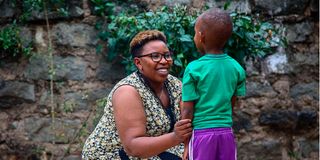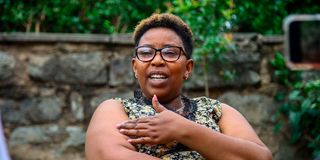
Grace Nduta Njogu, a 40-year-old mother of two, at her home in Kahawa Sukari, Kiambu County, interacts with her son during an interview on breastfeeding on August 2, 2024.
In 2018, Grace Nduta made a bold decision. She was pregnant and had just been diagnosed with breast cancer stage 3b. Against her doctor’s advice, she refused to terminate the pregnancy. The doctor warned her that if she waited nine months, the cancer would spread, and the drugs could harm the foetus.
“I was two weeks pregnant when I was diagnosed with breast cancer. The doctors kept telling me, ‘You have to start on chemotherapy immediately.’ I refused an abortion. They were shocked, but I eventually agreed to a mastectomy (removal of the diseased breast) because the lump in my breast was 7.6 centimeters big,” she says.
On the day of the mastectomy, Grace remembers lying on the theatre table at Kenyatta National Hospital and telling the breast surgeon, “You do your job well, I know I will wake up from this surgery.” She told Nation Lifestyle that she had absolute faith in her survival.
Had Grace not been pregnant, the mastectomy would have been just like the many procedures that surgeons do.
Despite the risks, she had a relatively easy pregnancy and delivered a healthy baby at 32 weeks via Cesarean section, weighing three kilos.
“Funny enough, he was bigger than his older siblings at birth,” Grace says.
For most women, having two breasts enables them to be physiologically prepared to nurse their children. Grace says having one breast was a challenge. “I would stand in front of the mirror, see the flat side and my growing belly, and cry,” she says.
But when the baby came, she vowed to breastfeed him.
“Breastfeeding helped me not only bond with my son but also fight the disease. I would gaze at him as he fed. Now we’re very close,” she says. “I combined breastfeeding, frantic pumping, and formula. Sometimes I would express milk and fill the 120-ml bottle with one breast.”
However, not everyone around her was cheering her on as she breastfed.
“They told me, ‘you don’t really have to breastfeed that child.’ They warned me that I might transfer cancer cells to my son. Some told me that I’d kill the child with the breast milk but I ignored them,” she says.
Supply challenges
Milk production was also not easy. Compared to her first child, when she had both breasts, she noted a difference.
“With two breasts, you can switch between breasts while feeding the child. My milk flow wasn’t sufficient, so I supplemented with formula,” she says.
When her son was latching on one breast, was she feeling sensations on the other side?
“Yes, I could feel it, but the doctor gave me some injections that reduced the feeling,” she says.
Self-image was another challenge. “I had many thoughts racing at once. I kept wondering how I would survive with one breast.
As a mother, when you breastfeed in public, it is perfectly okay to wop the breast out. Was Grace able to mute the lingering shame of the scar if people were to see it?
“At first, it was tough. In fact, when the doctor was explaining mastectomy, I asked him, ‘Will you remove part of the breast?’ He said he would remove the whole breast. I had never seen or heard of anyone with one or no breast. It was so shocking for me,” she says.
Chemo at last
When the baby was five months old, Grace continued with the second treatment.
“I did the chemo but I stopped midway because the side effects were too harsh. I took a break from treatment, and resumed breastfeeding until my son was eight months old. Then I did a total of six cycles of chemotherapy and finished in January 2021, when my son was almost two years old,” she says.
Chemotherapy and taking care of a newborn can be very draining. How did she handle it?
“It wasn’t easy. I had two fresh wounds – the C-section and the chest wound, and hair loss from the chemo. I cried, asking God why this had to happen,” she tells Lifestyle.
She remembers one day when she was going for wound dressing at a nearby clinic. Because the wound in her chest was still raw, she could not wear an artificial breast.
“I met a neighbour. She looked at me and asked, ‘why are you very flat on this side?’ pointing at my chest. I hadn’t told my neighbours that I had breast cancer. I started crying, but I couldn’t tell her why I was crying,” she says.
“I pitied myself as the woman with one breast. I avoided family gatherings, imagining people would notice. I used to remain home and cry. However, meeting and interacting with other breast cancer survivors at Kenyatta National Hospital helped. Some had lost both breasts,” she says.

Grace Nduta Njogu during an interview on breastfeeding on August 2, 2024.
Using an artificial breast later on improved her self-image.
“I remember when my relatives came to see my son, as is tradition in Africa. He started crying, wanting to breastfeed. I removed my breast and strategically covered the other side. It was only me who knew there was something I was hiding.”
Five years old
Life knocks everyone around a little, Grace says, but you pick yourself up and dust yourself off. You keep going, then you just keep going some more. So is this all over? We ask.
“I don’t know what to say. I don’t know whether to call the devil is a liar, or to focus on God’s miraculous works, because in 2022 [five years after diagnosis], I started coughing. I went back to the hospital, only for them to tell me, ‘you know what Grace, the cancer cells have moved to your lungs.’ And whenever the cells move, they classify it as stage four,” she says.
She is now on anti-cancer oral drugs and remains hopeful.
“In October, I’ll go for a review and by God’s grace, I’ll be okay.”
What gives her strength is looking back to the day she woke up from the theatre and found herself with bandages and tubes under her skin to drain fluid from the wound after the mastectomy.
“It was hard to sleep with hanging tubes and bandages, all while being pregnant. The nights were very tough,” she says, “And yet I made it.”
Grace has advice for other mothers with breast cancer who are looking to breastfeed. “Here’s the good news. My son, Hezekiah is now five years old. I breastfed him for two years.”
At her home in Nairobi, her son is just from school. He giggles as he touches his mother’s cheeks.
“I named him Hezekiah, meaning God’s Strength. Just like Hezekiah, I pleaded that our lives be prolonged,” she says.
Second mother
For Husseina Islam, a mother of two, uneven milk production forced her to nurse her first baby with one breast. One breast produced ample milk, while the other produced little drops.
She attributes this to stress and a demanding work schedule.
“I was only using one breast,” she says.
Her difficulties escalated with her second child, who was born prematurely and initially rejected the breast. Despite the 12-year age gap between her children, the challenges remained. Husseina experienced painful breasts and developed wounds.
The “good breast” became swollen and ceased milk production. It was very painful. I would massage it with a sponge dipped in warm water and then squeeze the milk manually rather than use a breast pump. At first, doctors had to poke it three times before milk started to flow again. It was a very traumatic experience,” she recalls.
Feeding the premature baby was a challenge, but Husseina found a solution by holding him in a kangaroo position, which eventually helped him latch on. She managed her challenges by expressing and storing milk to help feed the baby while she was at work.
“I did my best to express enough milk when I was home. The small bottle would last half a day,” she says.
Did she ever think of quitting? Husseina says cultural practices influenced her decision to breastfeed no matter what. In Muslim culture, breastfeeding typically stops when the child turns two. She stopped breastfeeding her first child at six months but continued with her second until he was two.
Similar struggles
Emmaculate Anyando, a mother of two, also shares similar struggles. When she gave birth to her first son, she faced serious difficulties.
“After a day, I tried breastfeeding from both breasts, but one failed,” the 38-year-old recounts.
The breast that wouldn’t produce milk developed a painful swelling, which forced her to stop using it.
“Desperate for relief, I tried using warm water to alleviate the pain and stimulate milk flow, to no avail. I eventually had to stop using that breast. Over time, the problematic breast shrank while the other one remained functional,” she says.
Emmaculate managed to breastfeed with one breast until her baby was nine months old. When he fell ill, she switched to solid foods. “He grew up healthy despite the challenges,” she adds.
With her second child, the milk supply issues persisted.
“I had the same problem and could only breastfeed from one side,” she says.
Emmaculate describes her breastfeeding season as challenging. “I felt cold, developed fever-like symptoms, and experienced discomfort when I stopped breastfeeding,” she explains.
Despite feeling dizzy and struggling with a low milk supply, she satisfied her babies with formula milk.
She sought medical help, but doctors could not identify a specific problem. Her main concern was the imbalance between her breasts. Due to work commitments, her breastfeeding journey with her second child ended around eight months ago.
Her firstborn is now 17, and her second child is seven. “I never went for any further medical attention,” she says.
So, what causes uneven milk production between breasts? Dr Emily Njuguna, a pediatrician, says ,“Women breastfeeding from one breast is not typical,” she explains. “Both breasts should produce milk simultaneously due to hormonal physiology.”
She says the solution lies in examining both breasts for issues like lumps, engorgement, mastitis, or cracked nipples. “If these are absent, we check for issues like flat or inverted nipples, which can prevent proper latching.”
A heavy let-down reflex can also cause discomfort for the baby. “A heavy flow can choke the baby, making breastfeeding uncomfortable. We teach mothers techniques to slow down their let-down reflex.”
Comprehensive medical evaluations are crucial to rule out any conditions hindering breastfeeding. “We refer women to obstetricians and gynecologists to check for diseases. If found, appropriate management is initiated,” says Dr Emily.
Maternal mental health and self-care significantly affect milk production. “We encourage mothers to rest, hydrate, exercise, and maintain a balanced diet,” she advises.
Dr Emily underscores the importance of multidisciplinary support. “Lactation specialists assist mothers and babies in breastfeeding. Although there is only one internationally certified lactation consultant in Kenya, there are many trained specialists.”
This is the last part series on Breastfeeding to mark World Breastfeeding Week.
Share your feedback to [email protected]










